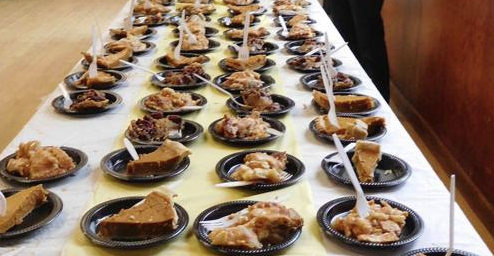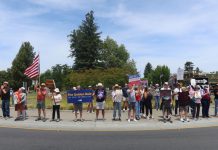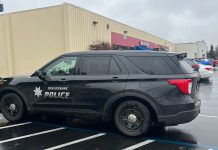On Nov. 9 the County of Sonoma announced it had joined nine other Bay Area counties to issue the same recommendations for safer holidays and travel. Sonoma, Alameda, Contra Costa, Marin, Monterey, Napa, San Mateo, San Francisco, Santa Clara, Santa Cruz counties and the city of Berkeley are aligned in how best to safely celebrate the upcoming winter gatherings and what to consider if you must travel in order to minimize the spread of COVID-19.
“With the number of positive cases on the rise nationwide, we need to work together to help stop the spread. Although some traditions will have to be put on hold this year, there are still multiple ways to have a Happy Thanksgiving, and maybe even create some new traditions,” the county said in a statement.
Gatherings
The safest gathering is one that is a small, stable group that meets outdoors for a short duration and uses face coverings, distance and other safety measures.
Any activity outside of your household increases chances of exposure to the virus. Be selective and space out which public activities you choose. If gathering with your small, stable group is most important, consider forgoing or delaying other activities such as a haircut or indoor dining to reduce your overall exposures and protect your group.
If anyone in your household develops COVID-19 symptoms after attending a gathering:
- Get tested for COVID-19
- Notify the other attendees as soon as possible regarding the potential exposure
- Stay home as much as possible for 14 days after the gathering or until the household member tests negative
- Avoid being around people who have higher risk for severe illness from COVID-19
If you gather in person, keep it safe, small, short and stable.
Outside is Safer: Gather outside and follow safety guidelines
The risk of COVID-19 transmission is highest in indoor spaces without enough ventilation. That’s why gathering inside is not allowed, except as permitted under the state’s health order. Outdoor spaces that are covered are okay, as long as 75% of the space is open to the outdoors. People may go inside to use restrooms, as long as restrooms are sanitized often and attendees only go one at a time.
Small: Limit gatherings to no more than three households
When people from different households are together at the same time in the same space, the risk of spreading COVID-19 goes up. That is why gatherings of more than 12 individuals and more than three different households are not allowed.
Short: Limit gatherings to no more than two hours
The longer people gather together, the higher the risk of COVID-19 spreading. That’s why gathering for longer than two hours is not allowed, under the state’s health order.
Stable: Do not participate in multiple gatherings with many different households
The more people come into contact with others outside their household, the higher the risk of spreading COVID-19. That’s why participating in multiple gatherings with different households is strongly discouraged. If you attend several gatherings over the holidays, keep it to the same group of people.
Considerations before hosting or attending:
- Are there many or increasing cases of COVID-19 in areas where attendees live?
- Have all attendees been taking precautions against COVID-19?
- Will all attendees wear face coverings and keep physical distance at the gathering?
Do not attend if:
- Anyone in your household has COVID-19-like symptoms
- You are at higher risk of severe illness from COVID-19 due to age or medical conditions
Hosts should let guests know safety guidelines must be followed before the event so everyone is aware.
Safety recommendations
- Maintain at least six feet of physical distance from people not in your household at all times, whether you’re sitting or standing. More distance is safer.
- Wear face coverings at all times, including when talking to others. You can remove face covering briefly to eat, drink or take medication as long as you stay at least six feet away from everyone outside your own household. More distance is safer.
- Remain outside as much as possible. If you go inside, open windows and doors to increase ventilation.
- Wash hands with soap and water often. If not available, use hand sanitizer.
- Serve shared food safely. If it is not possible to use single-serve disposable containers, food and beverages must be served by a person who washes or sanitizes their hands frequently and wears a face covering. If you are dropping off home-prepared food or drink gifts, be sure to wear a mask and disinfect or wash your hands thoroughly.
- Avoid singing, chanting, and shouting. If you cannot avoid these activities, keep your face covering on, your volume low, and at least a six-foot distance from others. More distance and being outdoors are safer.
Travel
Avoid travel during the holidays
COVID-19 is spreading rapidly in many parts of the country. Nonessential travel, including holiday travel, is not recommended. Traveling outside the Bay Area will increase your chance of getting infected and spreading the virus to others after your return. Additional precautions should also be taken when hosting and interacting with people traveling to the Bay Area, especially from other areas with widespread COVID-19.
If you travel outside the Bay Area, it is strongly recommended that you self-quarantine for 14 days after your return if your activities while traveling put you at higher risk of getting COVID-19. These higher risk activities include:
- Spending time within six feet of people you do not normally live with, while you or anyone around you was not wearing a face mask — especially if you were indoors.
- Traveling on planes, buses, trains, public transportation or other shared vehicles, if face masks were not worn at all times by both you and the other people in the vehicle.
Do not travel if you are sick. You could spread COVID-19 or another infection.
If you have COVID-19 symptoms, get tested and wait for a negative test result before you start your trip. Even if you test negative for COVID-19, you should not travel if you’re feeling ill as you may spread another infection.
If you must travel, take steps to reduce risk
- Wear a face covering
- Keep at least six feet of physical distance from others (more distance is safer)
- Ventilate your space, if possible (for example, open the bus or taxi window)
- Wash or sanitize your hands often
- Avoid touching your eyes, nose and mouth
- Avoid contact with anyone who is sick
- Avoid contact with frequently touched surfaces
- Get tested before and after you travel
- Get a flu shot
Air travel
Most viruses do not spread easily on flights because of how air circulates and is filtered on airplanes. However, it is likely that you will be sitting within six feet of others for long periods of time, which can increase your risk of getting COVID-19. Air travel also requires spending time in security lines and airport terminals, which can bring you in close contact with other people and frequently touched surfaces. Finally, during the holidays, planes and airports may be significantly more crowded than usual, which also increases risk of transmission.
Car travel
Don’t share vehicles with people you don’t live with. Vehicles are small enclosed spaces where COVID-19 can spread easily between people. If you must share a vehicle, try to ride with the same people each time, make sure everyone wears a face covering and open the windows to maximize outdoor air circulation as much as you can.
If you must travel, plan ahead and ask yourself the following questions?
Is COVID-19 spreading where you are traveling?
The more cases at your destination, the more likely you are to get infected during travel and spread the virus to others when you return. For cases in the last 7 days by state, see https://covid.cdc.gov/covid-data-tracker/#cases_casesper100klast7days
Are you, your travel companions, or those you are visiting at higher risk for serious illness?
Older adults and people with underlying medical conditions are more likely to get really sick if they get COVID-19. The virus can be spread among people who are not feeling any symptoms.
Will you be able to socially distance from others during your trip?
It is hard to maintain six feet of space from others when using public transportation like airplanes, buses, trains and taxis. Even when traveling in your own vehicle, you may find yourself in close contact with other people and frequently touched surfaces while making stops along the way.
Can you watch for symptoms and get tested?
In the event that you must travel, it’s important to monitor yourself for symptoms for 14 days after your return and get tested immediately if you have any symptoms. Even if you don’t develop symptoms, consider getting tested around three to seven days after your return, particularly if returning from an area with more COVID-19 transmission than we have in the Bay Area, or if you engaged in activities that put you at risk for getting COVID-19.
If you do any activity where you might have been exposed to COVID-19, including travel, reduce your contact with other people as much as possible for 14 days, keep your distance from others, and make extra sure that you always wear a face covering anytime you’re outside your household.









